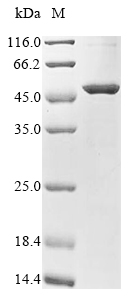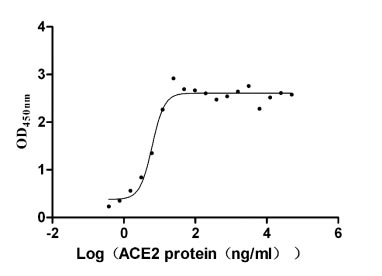Recombinant Mouse Lipoprotein lipase (Lpl)
-
货号:CSB-MP013065MO
-
规格:¥3960
-
图片:
-
其他:
产品详情
-
纯度:Greater than 85% as determined by SDS-PAGE.
-
基因名:
-
Uniprot No.:
-
别名:Lpl; Lipoprotein lipase; LPL; EC 3.1.1.34
-
种属:Mus musculus (Mouse)
-
蛋白长度:Full Length of Mature Protein
-
来源:Mammalian cell
-
分子量:55.3 kDa
-
表达区域:28-474aa
-
氨基酸序列ADAGRDFSDIESKFALRTPEDTAEDTCHLIPGLADSVSNCHFNHSSKTFVVIHGWTVTGMYESWVPKLVAALYKREPDSNVIVVDWLYRAQQHYPVSAGYTKLVGNDVARFINWMEEEFNYPLDNVHLLGYSLGAHAAGVAGSLTNKKVNRITGLDPAGPNFEYAEAPSRLSPDDADFVDVLHTFTRGSPGRSIGIQKPVGHVDIYPNGGTFQPGCNIGEAIRVIAERGLGDVDQLVKCSHERSIHLFIDSLLNEENPSKAYRCNSKEAFEKGLCLSCRKNRCNNLGYEINKVRAKRSSKMYLKTRSQMPYKVFHYQVKIHFSGTEDGKQHNQAFEISLYGTVAESENIPFTLPEVSTNKTYSFLIYTEVDIGELLMMKLKWISDSYFSWPDWWSSPSFVIERIRVKAGETQKKVIFCAREKVSHLQKGKDSAVFVKCHDKSLKKSG
Note: The complete sequence including tag sequence, target protein sequence and linker sequence could be provided upon request. -
蛋白标签:N-terminal 10xHis-tagged and C-terminal Myc-tagged
-
产品提供形式:Liquid or Lyophilized powder
Note: We will preferentially ship the format that we have in stock, however, if you have any special requirement for the format, please remark your requirement when placing the order, we will prepare according to your demand. -
缓冲液:If the delivery form is liquid, the default storage buffer is Tris/PBS-based buffer, 5%-50% glycerol.If the delivery form is lyophilized powder, the buffer before lyophilization is Tris/PBS-based buffer, 6% Trehalose.
-
复溶:We recommend that this vial be briefly centrifuged prior to opening to bring the contents to the bottom. Please reconstitute protein in deionized sterile water to a concentration of 0.1-1.0 mg/mL.We recommend to add 5-50% of glycerol (final concentration) and aliquot for long-term storage at -20°C/-80°C. Our default final concentration of glycerol is 50%. Customers could use it as reference.
-
储存条件:Store at -20°C/-80°C upon receipt, aliquoting is necessary for mutiple use. Avoid repeated freeze-thaw cycles.
-
保质期:The shelf life is related to many factors, storage state, buffer ingredients, storage temperature and the stability of the protein itself.
Generally, the shelf life of liquid form is 6 months at -20°C/-80°C. The shelf life of lyophilized form is 12 months at -20°C/-80°C. -
货期:18-28 business days
-
注意事项:Repeated freezing and thawing is not recommended. Store working aliquots at 4°C for up to one week.
-
Datasheet & COA:Please contact us to get it.
引用文献
相关产品
靶点详情
-
功能:Key enzyme in triglyceride metabolism. Catalyzes the hydrolysis of triglycerides from circulating chylomicrons and very low density lipoproteins (VLDL), and thereby plays an important role in lipid clearance from the blood stream, lipid utilization and storage. Although it has both phospholipase and triglyceride lipase activities it is primarily a triglyceride lipase with low but detectable phospholipase activity. Mediates margination of triglyceride-rich lipoprotein particles in capillaries. Recruited to its site of action on vascular endothelium by binding to GPIHBP1 and cell surface heparan sulfate proteoglycans.
-
基因功能参考文献:
- LPL-mediated release of essential fatty acid DHA regulates hematopoietic stem progenitor cell expansion and definitive hematopoiesis PMID: 29615667
- the negatively charged IDR of GPIHBP1 traverses a vast space, facilitating capture of LPL by capillary endothelial cells and simultaneously contributing to GPIHBP1's ability to preserve LPL structure and activity. PMID: 29899144
- LPL in the hypothalamus is an important regulator of body weight and glucose homeostasis PMID: 28456865
- These results identify LPL as an important regulator of fatty acid transport to skeletal compartments and demonstrate an intricate functional link between systemic and skeletal fatty acid and glucose metabolism. PMID: 28608812
- mutation of a conserved cysteine in GPIHBP1 abolishes the ability of GPIHBP1 to bind LPL PMID: 28476858
- The data suggests that ANGPTL3 is part of the machinery causing dyslipidemia majorily via LPL inhibition in mastitis mice. PMID: 29104012
- Using in vitro ketosis model by glucose starvation, studied inhibition of ketosis by momilactone B. Found momilactone B could regulate the angiopoietin-like-3 (ANGPTL3)-lipoprotein lipase (LPL)pathway, and suppressed the expression of HMGCS2 through the increased expression of STAT5b. PMID: 27874312
- physiological changes in adipose tissue ANGPTL4 expression during fasting and cold resulted in inverse changes in the amount of mature-glycosylated LPL in wild-type mice, but not Angptl4(-/-) mice. We conclude that ANGPTL4 promotes loss of intracellular LPL by stimulating LPL degradation after LPL processing in the endoplasmic reticulum (ER). PMID: 27034464
- LPL moved quickly from heparan sulfate proteoglycans (HSPGs) on adipocytes to GPIHBP1-coated beads, thereby depleting LPL stores on the surface of adipocytes. We conclude that HSPG-bound LPL in the interstitial spaces of tissues is mobile, allowing the LPL to move to GPIHBP1 on endothelial cells PMID: 27811232
- our study reveals that hepatic LPL is involved in the regulation of plasma LPL activity and lipid homeostasis. PMID: 27234787
- The induction of LPL activity by fasting in core transgenic mice activated PPARalpha downstream target genes that are involved in fatty acid beta-oxidation. PMID: 27665576
- This study shows that TNF-alpha, by a Foxo1 dependent pathway, increases the transcription of ANGPTL4 which is secreted by the cells and causes inactivation of LPL. PMID: 28215713
- Our findings suggest that neuronal LPL is involved in the regulation of body weight and composition in response to either the change in quantity (HF feeding) or quality (n-3 PUFA-enriched) of dietary fat PMID: 27282869
- An LPL structural model suggests that the LPL S447X truncation exposes residues implicated in LPL binding to lipoprotein binding uptake receptors, such as GPIHBP1. PMID: 27984852
- feeding induces lipasin, activating the lipasin-Angptl3 pathway, which inhibits LPL in cardiac and skeletal muscles to direct circulating TAG to WAT for storage PMID: 26687026
- MiR-590 agomir down-regulates LPL mRNA and protein expression in a mouse model of atherosclerosis. PMID: 26397958
- Deficiency of Lipoprotein Lipase in Neurons Decreases AMPA Receptor Phosphorylation and Leads to Neurobehavioral Abnormalities in Mice PMID: 26263173
- Systemic LPL deletion results in impaired glucose tolerance, whole-body and tissue-specific insulin resistance, which is associated with tissue lipid deposition in various insulin target tissues PMID: 25635326
- Results indicated that aggregation of alpha-syn and reduction of UCHL1 expression in LPL-deficient mice may affect synaptic function. PMID: 25595992
- the amount of LPL expressed in muscle and heart governed both the binding of chylomicron particles and the assimilation of chylomicron lipids in the tissue. PMID: 25589507
- Maternal overnutrition induces LPL expression in trophoblasts by reducing the inhibitory effect of SIRT1 on PPARgamma. PMID: 25948680
- Lipoprotein lipase is an important modulator of lipid uptake and storage in hypothalamic neurons. PMID: 26265042
- Results suggest that impaired synaptic vesicle recycling results from deficient docosahexaenoic acid and arachidonic acid and contributes to the presynaptic dysfunction and plasticity impairment in LPL-deficient neurons PMID: 25194787
- Adipocyte-specific Sel1L-deficient (AKO) mice are resistant to diet-induced obesity. Sel1L stabilizes and prevents LPL dimers from aggregation in the endoplasmic reticulum. PMID: 25066055
- This study showed that phloridzin improved plasma lipoprotein lipase activity via a decrease of ANGPTL4 mRNA expression and an increase of AMP-activated protein kinase phosphorylation. PMID: 24932810
- TRL margination depends on LPL bound to GPIHBP1. PMID: 24726386
- LpL hydrolysis of circulating lipoproteins is required for the accumulation of lipids in the heart of fasting mice. PMID: 24493834
- The expression levels of miR-27a and miR-29a inversely correlate with the mRNA levels of lipoprotein lipase and its key transcriptional regulator peroxisome proliferator-activated receptor gamma during 3T3-L1 adipocyte differentiation. PMID: 24457907
- Leu452His mutation in lipoprotein lipase gene transfer associated with hypertriglyceridemia in mice in vivo. PMID: 24086538
- PPARgamma1 was intimately involved in LPL gene expression in skeletal muscle and the AMPK-PPARgamma1 pathway may play a role in exercise-induced LPL expression. PMID: 24644240
- Activated cyclin-dependent kinase 5 promotes microglial phagocytosis of fibrillar beta-amyloid by up-regulating lipoprotein lipase expression. PMID: 23816988
- inactivation of LPL by Angptl4 appears to occur after both proteins have traveled along the secretory pathway and arrived at the cell surface. PMID: 24220340
- The present study showed that miR-467b protects apoE(-/-) mice from atherosclerosis by reducing lipid accumulation and inflammatory cytokine secretion via downregulation of LPL expression. PMID: 24309104
- Lipoprotein lipase activity decreases in adipose tissue during fasting. PMID: 23176178
- Macrophage LpL plays an important role in the development of atherosclerosis but not adiposity. PMID: 23378601
- LpL has a role as the "gatekeeper" for tissue lipid distribution and its deficiency more profoundly affects brown than white fat biology PMID: 23542081
- Neither a high fat diet nor fasting/re-feeding markedly altered the distribution pattern of LPL or GPIHBP1 in mouse pancreas. PMID: 23186339
- Findings indicate that miR-467b may regulate lipid accumulation and proinflammatory cytokine secretion in oxLDL-stimulated macrophages by targeting the LPL gene. PMID: 22963823
- ABCG1 controls LPL activity and promotes lipid accumulation in human macrophages in the presence of triglyceride-rich lipoproteins. PMID: 22772754
- variation in Lmf1 expression is a posttranslational determinant of LPL activity. PMID: 22345169
- lipoprotein retention in Bruch's membrane is mediated by lipoprotein lipase PMID: 21801873
- Hematopoietic cell-derived LPL could efficiently ameliorate severe hypertriglyceridemia and hypo-alpha-cholesterolemia at the compensation of increased triglyceride content of liver PMID: 21980507
- These results suggest that downregulation of miR-467b is involved in the development of hepatic steatosis by modulating the expression of its target, LPL. PMID: 21986524
- Uptake of dietary retinoids at the maternal-fetal barrier: in vivo evidence for the role of lipoprotein lipase and alternative pathways. PMID: 21795711
- LPL gene expression appears to be under dietary control: supplementation with cyanidin-3-O-beta-glucoside appears to up-regulate LPL in plasma and skeletal muscle but down-regulate LPL in visceral adipose tissue in the KK-Ay mouse model of diabetes PMID: 21360538
- the cleavage of ANGPTL4 by these PCs modulates its inhibitory effect on LPL activity. PMID: 21398697
- LPL is a novel Abeta-binding protein promoting cellular uptake and subsequent degradation of Abeta. PMID: 21177248
- Data show that apoC-II and LPL mRNAs correlate temporally and geographically with surfactant lipid synthesis in preparation for birth and suggest that fatty acid recruitment from the circulation by apoC-II-activated LPL is modulated by apoC-II secretion. PMID: 21059267
- PPAR-alpha response is generated by unbound fatty acids released locally by lipase activity and not by circulating plasma fatty acids. PMID: 20421589
- Results show that cotransfection of LPL with wild-type Lmf1 restores its ability to support normal lipase maturation. PMID: 19471043
显示更多
收起更多
-
亚细胞定位:Cell membrane; Peripheral membrane protein; Extracellular side. Secreted. Secreted, extracellular space, extracellular matrix.
-
蛋白家族:AB hydrolase superfamily, Lipase family
-
组织特异性:Detected in white and brown adipose tissue and heart muscle, especially at the lumenal surface of capillaries. Detected on capillary endothelium in the lactating mammary gland. Detected in blood plasma (at protein level). Expressed in liver, epididymal fa
-
数据库链接:
KEGG: mmu:16956
STRING: 10090.ENSMUSP00000015712
UniGene: Mm.1514
Most popular with customers
-
Recombinant Paguma larvata Angiotensin-converting enzyme 2 (ACE2), partial (Active)
Express system: Mammalian cell
Species: Paguma larvata (Masked palm civet)
-
Recombinant Human C5a anaphylatoxin chemotactic receptor 1 (C5AR1)-VLPs (Active)
Express system: Mammalian cell
Species: Homo sapiens (Human)
-
Recombinant Human Angiopoietin-2 (ANGPT2) (Active)
Express system: Mammalian cell
Species: Homo sapiens (Human)
-
Recombinant Human Intestinal-type alkaline phosphatase (ALPI) (Active)
Express system: Mammalian cell
Species: Homo sapiens (Human)
-
Recombinant Human Tumor-associated calcium signal transducer 2 (TACSTD2), partial (Active)
Express system: Mammalian cell
Species: Homo sapiens (Human)
-
Recombinant Human Desmoglein-2 (DSG2), partial (Active)
Express system: Mammalian cell
Species: Homo sapiens (Human)





-AC1.jpg)













